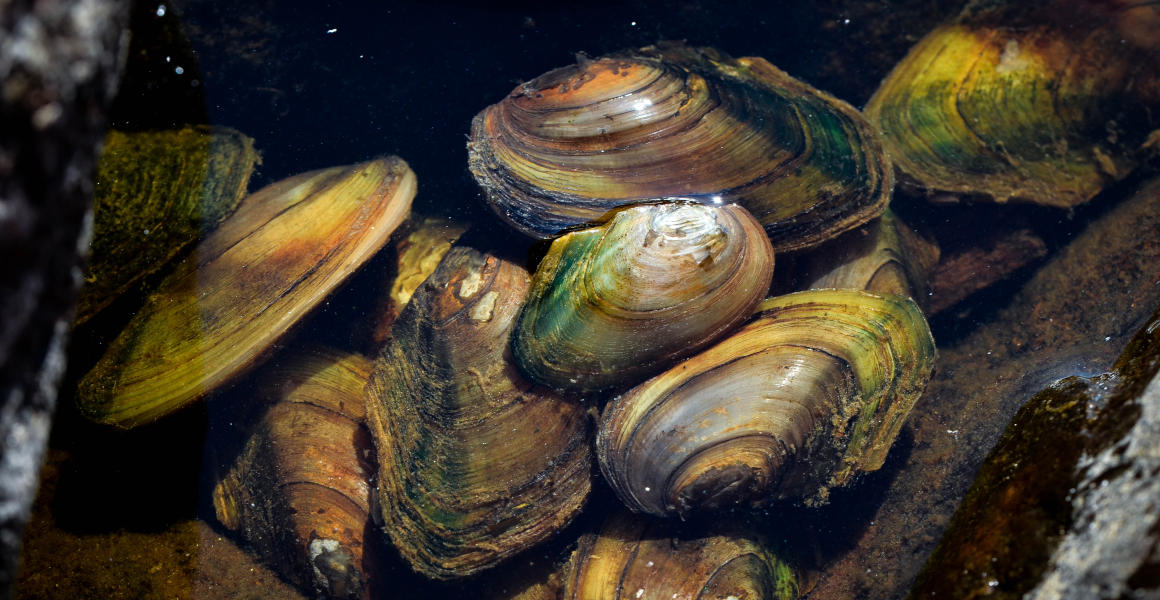
Mussels in the Thames have declined by 95% since the 1960s
Numbers of mussels in the River Thames could be at just 5% of the level they were almost 60 years ago.
Research conducted by the University of Cambridge in 2020 replicated a survey of the river from 1964 at a site near Reading, revealing that the UK’s freshwater mussels are being put under increasing pressure following the arrival of invasive species.
The results of the study, which has now been published in the Journal of Animal Ecology, showed that no depressed river mussels remained in this section of the Thames. Only empty shells were left to show that one of Europe’s most threatened mussel species once lived there.
PhD student Isobel Ollard, who led the study, says, ‘The depressed river mussel used to be quite widespread in the Thames, but this survey didn’t find a single one, which raises concerns for the survival of this species.’
‘More widely, mussels are a great indicator of the health of the river ecosystem. Such a massive decline in mussel biomass in the river is also likely to have a knock-on effect for other species, reducing the Thames’ overall biodiversity.’
While the declines are significant, it isn’t all bad news for the health of the Thames. Despite the mussels growing more slowly than they did in the 1960s, this is believed to be the result of the river becoming cleaner as levels of nutrient pollution return to more natural levels.

Mussels are a group of sometimes distantly related molluscs which share characteristics such as their shape. Image © University of Cambridge
What are mussels?
Mussels are not one group of animals, but a number of different bivalve species that all look similar to each other. They are all a part of the mollusc family and feed by filter feeding. This involves drawing water into the shell and extracting microbes and nutrients from it.
There are two main groups of mussels, of which the marine mussels are the ones you have most likely encountered as food.
These mussels live along shorelines and in other saltwater habitats and have evolved ways to withstand buffeting by strong tides, including strong adhesives which are being investigated for ways to produce organic glues that work underwater and for medical purposes inside the body.
However, the largest group of mussels live in freshwater, with an estimated 840 species worldwide. They’re not commonly eaten by people, but instead play a role as indicator species which show how healthy an ecosystem is.
This is because the mussels filter large amounts of water while feeding, and so are rapidly exposed to changes in pollution or nutrient levels in their environment. In part due to this exposure to changes in their environment, many species of mussel are in danger of being lost.
Around 40% are considered threatened or near threatened with extinction globally, and in North America, where freshwater mussel diversity is highest, this rises to over 70%. While there are only around 16 species of freshwater mussel in Europe, 12 are considered to be at risk of dying out, including three Critically Endangered species.
The construction of dams and the dumping of sewage into rivers are among some of the reasons these species are in decline, as well as invasive species. Zebra mussels are a particular threat as they can smother native species by growing on top of them, as well as outcompeting them for food.
Concerns over the health of the UK’s mussels led the researchers to repeat an experiment carried out in the 1960s to see how the species of the Thames had changed over time.

The 1964 study and the 2020 follow-up both took place in a stretch of the Thames near Wokingham Water Centre. Image © Roger Utting/Shutterstock
How have mussels in the Thames been affected?
To see how populations of mussels in the Thames were changing, the researchers tried to replicate the initial survey from 1964 as closely as possible. This included contacting the original scientist, Christina Negus, who is also notable for first discovering the ancient animal Charnia masoni.
Christina provided details of the methods and equipment she had used 56 years before. At the time, this research was notable for being one of the first scientifically rigorous surveys of mussels.
To do this, the researchers dredged mussels from one area of the river and took measurements of the species which were present. One immediate observation was that there were a lot fewer mussels than there were in the 1960s, with duck mussels dropping from around 12 individuals per square metre to less than one in 2020.
As a result, this formerly dominant species made up just 10% of all mussels in the sample. Other mussels are instead increasing their numbers, including native species like the swollen river mussel and non-native species such as the zebra mussel and the Asian clam.
Co-author Professor David Aldridge says, ‘This dramatic decline in native mussel populations is very worrying, and we’re not sure what’s driving it.’
‘While this might seem like a rather parochial little study of a single site in a single river in the UK, it actually provides an important warning signal about the world’s freshwaters.’
Not only are there now fewer mussels, but they are also smaller than they used to be. The biomass of the mussels is around 13 times lower than in 1964, while their productivity was almost 80 times lower.
Their slower growth is believed to be associated with declines in the levels of phosphorus and nitrate in the water, which promote the growth of algae that mussels can feed on.
These nutrients are less common due to the introduction of more stringent water treatment regulations since the 1960s which forbid waste dumping in the river in many circumstances.
As the Thames was already highly altered in the 1960s, with some sections being described as ‘biologically dead’, the researchers believe that this may represent a return to how mussels would normally grow in the river. Without a ‘healthy’ baseline to compare to, however, they can’t be completely sure.
The researchers have called for more frequent sampling of sites such as this to provide greater detail on the decline of freshwater mussels, which are still not well understood.


































